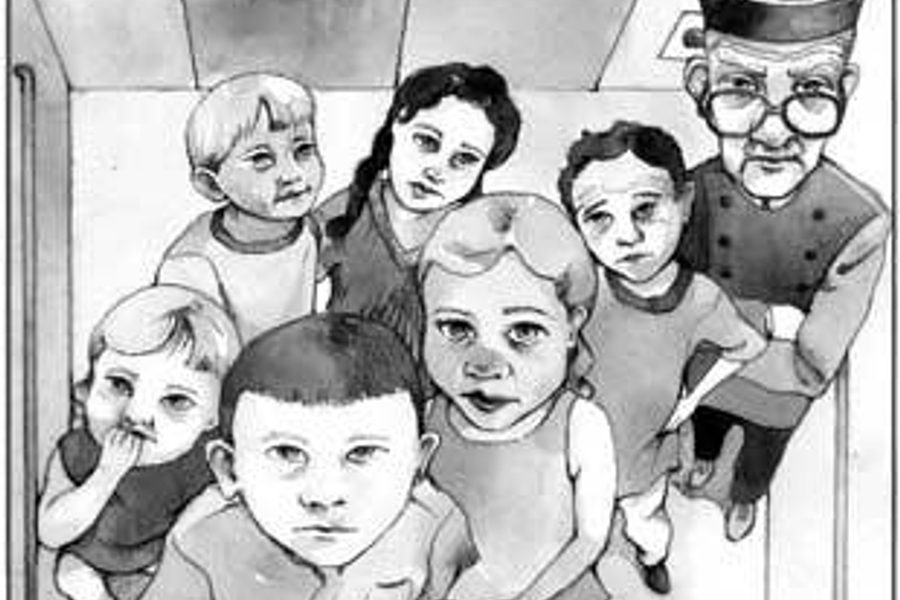
The “Face Aging” booth at the Boston Museum of Science attracted the longest lines of children. ¶ Access was forbidden to those over 15, so I watched from outside. The youngsters had their photographs taken and soon their digitized image appeared on a TV monitor. Then, tapping a button like a VCR remote, each child could call up simulations of what she or he would supposedly look like at one-year intervals up to their 60s. In seconds the computer added pouches, rouged skin and blotches; faces became elongated and then wider and then saggy; lines became heavier. Boys lost hair. Hair turned gray. The heads of both boys and girls grew and then shrank.
The children came out distracted, most edging away fast, not knowing what had happened to them. One 8-year-old girl moaned, “I don’t want to get old!” A boy said about another child, “He’s disgusting at 42.”
Everything promised scientific truth — its location in the Museum of Science; the title of the show, Secrets of Aging; the prestigious technologies involved. But next to nothing was scientific. The increasing facial redness as the children aged was an accident of the Kodak film they used. The blotches were unintentional, developing from freckles, moles and pimples the kids already had on their faces. The software, by C.O.R.E. Digital, which specializes in TV animation, added the wrinkles, swags and grayness.
The programmer wouldn’t say how the designers conceptualized “aging.” But they started with a photo of an 8-year-old girl and asked the staff if the image of her at 60-something was believable. The responses made them add more effects. These were arbitrary decisions. As Digital’s project manager observed: “It was only entertainment. We streamed together six or seven different ideas; we’re a special-effects studio.”
What exactly is wrong here?
First of all, the software engineers didn’t ask, “What’s the algorithm for making people look more beautiful, expressive or individual as they grow up?” because they worked from our culture’s preexisting notions of decline. Gerontologists on the Science Museum Exhibit Collaborative didn’t ask, as age critics should, “What future does this project for children? What story of aging does it tell?” They may not believe decline should be the acceptable life-course narrative for the young, but had they been warier about American age culture, the taunting title, “Face Aging,” would have raised an alarm.
People don’t realize that aging is a narrative. Where age is concerned, we are made to focus endlessly on the body, as if we had no minds, concepts or attitudes about age that influence how we look to ourselves. Before anything called aging happens in the body, it is a set of stories children hear about their future. These stories create expectations, lay the ground rules of life, shape what it means to be human.
Prospective age narrative in a normal American childhood is about progress, not decline. In a narrative of progress, the implicit meanings of aging run from development to survival, resilience, recovery and then on to collective resistance to decline forces.
Adults — middle-class people, mostly women — read books that tell them how to “get over” getting older, how to be successful at retirement. But such positive aging isn’t on display at the booth. Its monitor provides a startling example of decline forecasting: a wreck foretold about each and every tender body. “Face Aging” suggests that adults can’t believe in aging-as-progress anymore; aging-as-decline is the default story.
Something historic has changed, some new era has begun.
What does increasd longevity and improved health accomplish, if so many people are afraid of being old?
The real truth is that we are aged by culture. In our American case, the dominant culture reflects the needs and viewpoints of international capitalism in an era of globalization and inequality. The economy downsizes people at midlife; “anti-aging” ads and surgeries address people in their 40s and 30s; businesses outsource not just manufacturing, but white-collar jobs held by educated middle-class people. All of these cultural phenomena superannuate us prematurely, long before old age or retirement. Seniority systems — which provide the economic basis for respecting midlife workers — are eroding as labor unions weaken. Patriarchy used to protect midlife men in the middle and upper classes, but now — if we follow male midlife economic stagnation over the last 30 years — patriarchy seems weak in the face of capitalism’s race to the bottom.
Age is politicized to explain history: growing inequality, rising displacement, high unemployment, job scarcity. Baby Boomers allegedly war against Generation X because they are jealous of their youth, while younger people are told that aging Boomers hold the good jobs and only as they retire will they be available to the young. People aging into their middle years are told they are under-skilled, overpaid, narcissistic and over-entitled. Age is doing the same kinds of dirty work as gender, race and sexuality.
Despite the American Dream, decades of feminist anti-ageism and the much-touted power of the Boomers, American age culture uglifies time and passes off its squint as truth. Now we are telling our underlying national narrative of decline to people under 15. Economically and psychologically, we are losing the progress narrative of aging to which our national wealth, improved health and longevity should entitle us. Children are being prepared for decline as their future.
Thoughtful people wonder why we are so obsessed by age in America, why it seems so hard to hold on to respect for aging, to the values that make the life course feel valuable.
Children feel helpless looking into the crystal ball of aging because they don’t know it’s a fake. But how much better off are the grownups? Adults too are being made to stumble along the life course. The pain of decline, unless we are very privileged, will hit us long before the body begins to fail. Sexism, racism and homophobia are devastating. So is decline. Worse than ageism, worse than middle ageism, it is backing down the life course to ever-younger ages. We won’t need anti-aging products if we can identify the forces that endanger us. We need political resistance and will.
My hope is that thoughtful people learn to fight collectively against the forces producing decline. Perhaps it is utopian to imagine our children and ourselves feeling at home in the life course at every age. But no lesser goal can drive us to maintain the systems like seniority that work in favor of American age culture and progress narrative, and to overthrow the forces that can still be fought.





